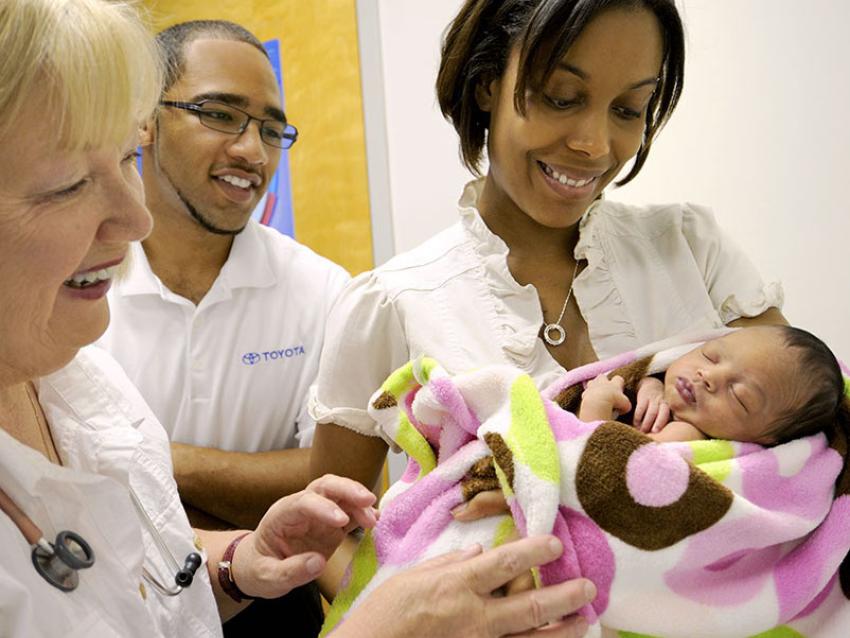
UK's College of Nursing BSN Program Covers Entire Lifespan: Starting Small
Infant
A baby in fuzzy yellow pajamas is staring with large unblinking eyes at the group of nursing students in front of her in a large lecture hall. She sticks a thumb in her mouth as Assistant Professor Carrie Gordy, MSN, APRN, asks for a student volunteer to come down to the front of the classroom. With a big smile, a sophomore-level nursing student approaches the infant and begins assessing her development.
This is Nursing 201: Assessment and Health Promotion—one of the first building blocks of the College’s undergraduate curriculum.
From the very beginning of life to the launching of adolescents into adulthood, pediatric nursing students trained at UK are equipped to confidently care for each patient at each stage of development.
“Where some nursing programs have cut back on pediatrics, obstetrics and some other areas, we feel that an understanding of family and each member of the family is really important,” explains Professor Patricia Burkhart, PhD, RN, associate dean of undergraduate faculty affairs at the College, and a nationally recognized expert in pediatric asthma management. “In our curriculum, we start with what is healthy and how to promote health, and then contrast that with patients who are ill.”
The healthy child in front of Gordy’s class is trying to “army crawl” after a blue ball that the student has gently rolled across the stage. The infant’s caregiver fields questions from the student. Was the infant premature? Has the baby started on solids? Can she roll over front to back? Back to front? The only question the caregiver cannot answer is how old the baby is.
“When the developmental mapping is complete, then they have to try to tell me what the baby’s age is based on their developmental milestones,” says Gordy.
Vicki Hensley, PhD, APRN, instructor for the College, takes a similar experiential learning approach. “You can talk about different strategies to get a child to cooperate when you are taking their blood pressure, but you don’t know what you are doing until you actually work with a child,” Dr. Hensley says. “You give students the opportunity to assess the patient and show them different milestones.”
Health and wellness instruction also extends out into the community. In local elementary schools, students teach children how to properly wash their hands, brush their teeth, and how to cough and sneeze to decrease germ transmission. They also take part in an after-school mentoring program where they help children with their homework and listen to their concerns.
Once students have a solid base of knowledge and skills related to health and wellness in their sophomore year curriculum, they transition to acute care. Junior-level students are at UK’s Kentucky Children’s Hospital working with acutely ill children for their pediatric clinical experiences. Cancer, heart defects, respiratory problems like asthma, cystic fibrosis, RSV, bronchiolitis and pneumonia are all illnesses that adults face, but in children they are a whole different ballgame.
“Kids are not miniature adults,” Dr. Burkhart explains. “Physiologically they are different than adults. Their metabolic rate is different so they metabolize medications differently. For example, if you gave an infant the same amount of IV fluid you would give an adult, you’d put them in circulatory overload.”
“In an acute care setting, a thorough understanding of a child’s developmental level is a critical part of their care,” Gordy says.
By 2016 the College plans to open a BSN-DNP Pediatric Acute Care Nurse Practitioner specialty. Only UK and one other school within a five-state radius will offer this specialty, filling a gap for high acuity care for children.
Preschool
“Preschool children are magical thinkers. To them their toys are alive; the toys talk and can feel. Band-Aids and mothers’ kisses have the power to make hurts feel better. They are one of the College of Nursing professors’ favorite age groups,” says Kari Blackburn, DNP, APRN, a certified pediatric nurse practitioner who works in a private pediatric urology practice in Lexington.
An experienced pediatric emergency department nurse, Dr. Blackburn’s type of work changed, but the patient population didn’t. She says, “Children need someone to take care of them. Unfortunately, I’ve seen a lot of kids that do not have the support they need at home and it’s terrible. So part of my purpose is to be their voice. I felt that as an ED nurse and I feel it as a nurse practitioner provider.”
Dr. Blackburn specializes in pediatric bladder control problems. She currently sees about 25 children a week who have constant leaking or full-blown urinary accidents—a condition known as functional elimination syndrome.
Walking into the exam room, Dr. Blackburn drops down to the patient’s level and begins by reassuring the child.
“I have to tell them I don’t have shots in my office,” Dr. Blackburn says with a smile. “That’s the typical age that needs to hear that when they go to a doctor’s office.”
From there, Dr. Blackburn walks children through what an ultrasound is, “lets the child hold the wand and explains that it will feel slippery on the tummy and won’t hurt. Treatment involves a lot of communication and training with the parent and child as they work to undo a learned behavior.
“Children don’t have a lot of comorbidities,” says Dr. Blackburn about the benefit of working with children. “They have more isolated complaints that you can focus on.”
Advocating for pediatric patients is what DNP alumna Andrea Sebastian, DNP, APRN, does on a daily basis. Dr. Sebastian is a nurse practitioner with the Child Advocacy Resource and Evaluation Services Team, Le Bonheur Children’s Medical Center in Memphis, Tennessee, and instructor at the University of Tennessee Health Sciences Center. Her passion for working in child advocacy was born out of her experiences as a bedside nurse.
“When I moved to Memphis, I discovered there were a lot of children who were victims of child abuse,” Dr. Sebastian recalls. “I was an experienced nurse, and I still had a hard time recognizing it and feeling comfortable reporting it.”
Dr. Sebastian’s DNP capstone project studied the reasons why bedside nurses find it so difficult to recognize and report suspected child abuse.
She now educates pediatric nurses and nurse technicians newly hired at Le Bonheur on recognizing and reporting cases of suspected child abuse.
“I feel like I’m making a difference and hopefully, helping these kids get out of dangerous situations,” says Dr. Sebastian.
School-age
Two cotton balls are poised on a small exam table. An 8-year-old child with asthma and Dr. Burkhart bend over the table, drinking straws at their lips.
“On your mark, get set, go!” With a deep intake of breath, the race is on and the two cotton balls are blown across the table. “You win!” Dr. Burkhart exclaims. “Now let’s try that with this.” She hands the child a peak flow meter that measures his maximum speed of expiration.
“School-age children are concrete thinkers,” explains Dr. Burkhart. “They aren’t abstract. You have to show them things.”
The ability to think creatively to achieve treatment and research goals is one of the hallmarks of an effective pediatric nurse practitioner and one of the things Leslie Scott, PhD, APRN, PPCNP-BC, MLDE, associate professor and pediatric nurse practitioner DNP specialty coordinator at the College, looks for when reviewing applicants for the PhD Program.
“We like to think that our PhD colleagues create the science through their research where the DNP provider incorporates the science into clinical practice and then evaluates the outcomes,” explains Dr. Scott. When she took over the Pediatric Nurse Practitioner Specialty in the DNP Program, it was transitioning from a master’s-level program to doctoral. Dr. Scott led the development of the doctoral-level curriculum.
“Pediatric nurse practitioners have an in-depth understanding of growth and development,” says Dr. Scott. “They are excellent at anticipatory guidance, patient teaching, as well as wellness and health promotion strategies.”
After treating numerous children with oppositional defiant disorder, Assistant Professor Dianna Inman, DNP, APRN, CPNP, PMHS, used skills developed during her doctoral work to seek a program with verified results that addressed this problem at its roots.
“As a DNP student, education equips you with the knowledge and tools needed to formulate clinical questions, search the literature and look for the best evidence to inform your practice,” says Dr. Inman. “We know that it takes, on average, 17 years to get research into practice. The doctorally prepared pediatric nurses will be able to evaluate the evidence and be those champions that we need them to be to get nursing research into practice much sooner.”
Dr. Inman’s championing lead her to The Incredible Years—a school-based social skills training program with 20 years of research to support its effectiveness in preventing and treating behavioral problems. Implementing the program in nine at-risk elementary schools became her doctoral capstone project.
“We have a long way to go in prevention, but it’s key,” says Dr. Inman. “Especially with children and adolescents, we can prevent many behavioral and mental health disorders if we intervene early. My doctoral work infusing this program into high-risk elementary schools decreased aggressive behavior by 30 to 50 percent.”
Adolescents
A tray sits between two adolescent boys with blood glucose meters, insulin and all the equipment necessary to monitor and manage their Type I diabetes. At this age it is appropriate for them to take an active role in the management of their condition. Developmentally, adolescents are establishing their independence, which sometimes makes it challenging for them to accept adult instruction. Pediatric nurse practitioners learn to help these adolescents reach a degree of independence in their daily management with minimal impact to their degree of disease control.
“Part of my role is to provide evidence-based projects and strategies to the nursing staff at UK HealthCare,” Dr. Inman continues. “This is another example of how advanced practice nurses can play a critical role in preventive patient care.”
Dr. Scott participates in a traveling diabetes clinic four times a year in Pikeville, Kentucky, and as a DNP student, Dr. Blackburn found the experience invaluable.
“That’s when I realized I wanted to work in a subspecialty,” she recalls. “It helped me see more of her life—what she does as a teacher and a provider and how she functions in a provider setting.”
“Our faculty members who practice spend a considerable amount of time with our students,” says Dr. Heath. “It is not the norm across the country for nursing educators but it’s absolutely critical. We have a good body of knowledge that demonstrates it’s the clinical experiences that produce the best learning. When students are given that hands-on experience, it’s easier to grasp and retain the didactic content.”
